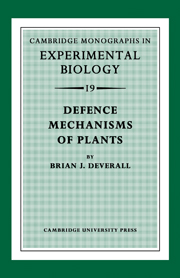Book contents
- Frontmatter
- Contents
- Preface
- 1 INTRODUCTION TO THE HOST–PARASITE INTERACTION
- 2 DISCRIMINATORY EVENTS BEFORE AND DURING PENETRATION INTO PLANTS
- 3 CYTOLOGICAL CHANGES IN HOST AND PARASITE AFTER INFECTION
- 4 CROSS-PROTECTION AND INDUCED RESISTANCE
- 5 PHYTOALEXINS AND THEIR INDUCED FORMATION AND BIOSYNTHESIS
- 6 ROLE OF PHYTOALEXINS IN DEFENCE MECHANISMS
- 7 MEDIATION OF HOST–PARASITE SPECIFICITY
- References
- Index
6 - ROLE OF PHYTOALEXINS IN DEFENCE MECHANISMS
Published online by Cambridge University Press: 10 May 2010
- Frontmatter
- Contents
- Preface
- 1 INTRODUCTION TO THE HOST–PARASITE INTERACTION
- 2 DISCRIMINATORY EVENTS BEFORE AND DURING PENETRATION INTO PLANTS
- 3 CYTOLOGICAL CHANGES IN HOST AND PARASITE AFTER INFECTION
- 4 CROSS-PROTECTION AND INDUCED RESISTANCE
- 5 PHYTOALEXINS AND THEIR INDUCED FORMATION AND BIOSYNTHESIS
- 6 ROLE OF PHYTOALEXINS IN DEFENCE MECHANISMS
- 7 MEDIATION OF HOST–PARASITE SPECIFICITY
- References
- Index
Summary
The fact of the existence of phytoalexins in at least some plant families, as discussed in the previous chapter, does not prove their role in the defence mechanisms of plants. It is tempting to ascribe a function for biologically active molecules isolated from living organisms, but important questions can be raised about the involvement of such molecules in the complex processes within living tissues. The general nature of these questions will be presented first, before moving on to a discussion of the nature of the evidence for the involvement of phytoalexins in disease resistance and in the processes controlling specialization in parasitism.
The need for caution in asserting a role in disease resistance for each anti-microbial compound extracted from a plant was emphasized by Daly (1972). Thus it is desirable to know whether the compound occurs at those micro-sites within a plant where it might contact a parasitic bacterium or fungus. The places in plants where different parasitic micro-organisms cease growth in resistant tissues were described in Chapter 3, but little information is available about the location of phytoalexins in the intercellular spaces, cell walls, cytoplasm, organelles and vacuoles of living cells, or about their movement in and around dead cells. Many phytoalexins are lipophilic and it is legitimate to ask whether they occur at these important micro-sites in plant tissues not only in sufficient concentration but also in the appropriate form to affect growth of parasites.
- Type
- Chapter
- Information
- Defence Mechanisms of Plants , pp. 62 - 74Publisher: Cambridge University PressPrint publication year: 1977



